- Opinion
- Posted
Breaking the Bank
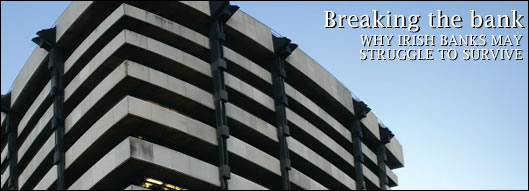
With banks in America and the UK encountering major difficulties as previously booming economies head towards recession, a similar and perhaps even worse fate may be awaiting Irish banks. Worryingly, the situation is shaping up to be so bad, that the very future of the banks may be under threat, as Richard Douthwaite explains.The outlook for the Irish banking system is extraordinarily bleak. That makes the outlook bleak for the rest of us too. It is hard to see how our businesses can be financed or our savings can be safe in the next year or two.
The banks' problem is systemic. It has arisen because most of their lending is based on asset values. The more an asset is worth, the more money that can be borrowed against it. Consider how this works. I go to my bank and arrange a loan to cover 90% of the e1million cost of a house or a shop, secured against the building itself. I put up the missing 10% personally. After the sale has gone through, the vendor lodges my cheque in her bank. This gives that bank funds to lend out and, since its business is lending money, it lends out 90% of its customer's deposit, keeping back 10% as a reserve. That e900,000 loan creates another deposit in another bank, and 90% of that will be lent out too. From bank to bank the deposits can go, each creating the basis for another, smaller loan, so by the time the effects of my initial e1million purchase have worked themselves through the system, loans totaling e10million will have been generated.
Most of the money generated by this lending cycle, which I started off with just e100,000, my 10% deposit, will have been spent on buying property or some other asset against which the banks were happy to lend. So, if many people are like me and begin borrowing to buy assets, the price of assets will go up, thus creating the collateral against which the banks can lend even more money. If they do lend - and why wouldn't they? - they will push the price of assets even higher and more and more people will rush to borrow from them to get on the property ladder. And so the cycle will go on and on.
This is how a property bubble is inflated and financed. Only two things limit how big the bubble can become. One is the ability of the borrowers to make the repayments on their loans. Unfortunately, however, when unaffordability became a severe problem in the housing market, the Central Bank allowed the commercial banks to side-step the limit by progressively reducing their lending standards. As recently as 2002, the banks restricted a couple seeking a mortgage to borrowing 2.5 times the primary income plus once times the secondary one. Now, five times the joint income is common and up to seven is still possible: I was quoted that when researching this article. Standards were also lowered when the banks started giving 100% mortgages and extended the mortgage period out to as long as 40 years.
The other limit should have been set by the international rules governing how much money each commercial bank can lend out in relation to the amount of capital it has and the riskiness of the loans it is making. Here, though, the banks evaded the limit by making loans and then getting them off their books so that they didn't have to increase their capital reserves to support them. This was done with the connivance of the Central Bank, whose duty it is to enforce the international rules.
Some American banks which hived off loans in this way have since found that the Structured Investment Vehicles (SIVs) they created to do so could not be allowed to fail without causing severe damage to their reputations. They had to take them back on to their books and suffered losses running into billions of dollars. Could the same thing happen here? Construct Ireland asked the Central Bank which declined to discuss the issue by replying “We cannot comment on [the] implications of hypothetical situations.” In fact, the Bank of Ireland released a trading statement this February saying it had lost e42million on its SIVs.
The Central Bank was able to be remarkably relaxed – some would say grossly negligent - about the amount of money it allowed the commercial banks to put into circulation because the resulting increase in spending power was having very little effect on the rates of wage and consumer-price inflation. These are the only types of inflation the bank feels it should worry about and, over the past few years, the Consumer Price Index has been controlled by the ready availability of cheap food and other goods from the rest of the world while wages have been held down by the influx of workers from Eastern Europe.
Asset price inflation, by contrast, is universally seen as a good thing. Just think about the difference in the attitudes expressed in the media when the stock market and house prices are going up and when they are coming down. One is a boom to be celebrated, the other a bust to be feared. Moreover, an expanding money supply is great for business profits because there's more money around to be shared around at the end of each year than there was at the beginning. And so the Central Bank regulators felt able to twiddle their thumbs while the banks were piling debt upon debt and expanding their loans to the private sector at, for a period, over 30% a year. At this rate, the total debt that Irish residents (which includes companies registered in Ireland) needed to service doubled in just over two years.
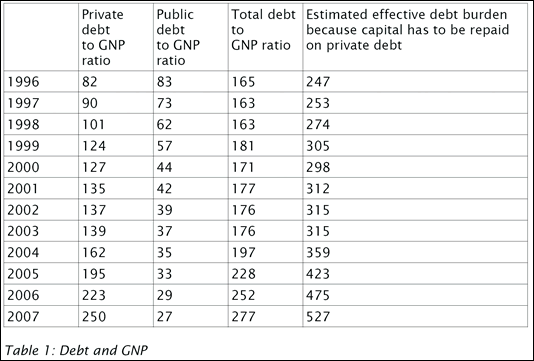
Our debts increased much more rapidly than our incomes. In 1997, Irish private sector debt was roughly equal to the total income accruing to Irish residents (including resident companies) each year. At the end of last year, the debt was around 2.5 times our income, as table 1 shows. This is by far the highest rate of indebtedness in the EU, as table 2 indicates, and makes Irish costs higher than elsewhere because the country is having to pay to service a much greater burden of debt than its international counterparts. When Forfas bemoans the loss of Irish competitiveness in export markets, this is what it should blame.
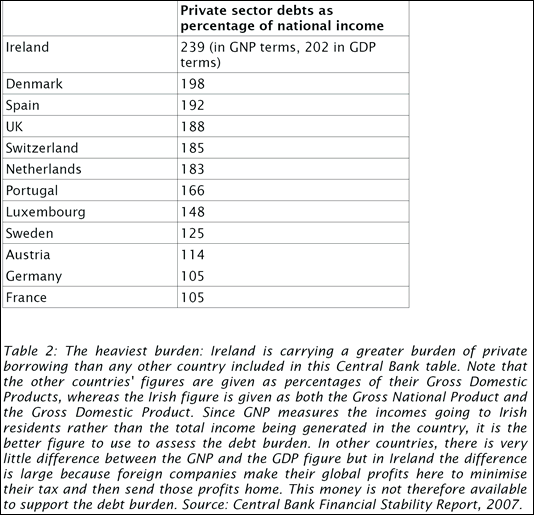
At the end of December, the staggering sum of e376,796,000,000 was owed by the private sector to the Irish banks. This works out at e91,700 for every man, woman and child in the country. The interest on this money alone works out at about e5,500 each if we assume the rate is 6% but that's not the only burden it places on us - the capital repayments have to be found, too. If you and your family don't owe this amount personally, you are still carrying the cost because every bill you pay has a margin for interest and for capital repayments included in the total. We are also paying interest on the the government's borrowings too but, these days, that's quite a small amount. The national debt was e36,928 million (roughly e9,000 per head) at the end of January, and the interest on that came to about e400 per person in 2007, a trivial amount in comparison with the private sector bill.
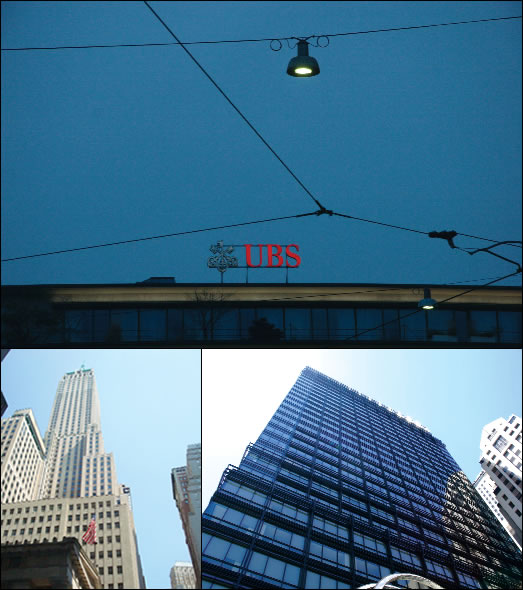
Some of the world’s biggest international banks have encountered difficulties due to the current economic climate, including UBS (top), Morgan Stanley (above right) and Citigroup (above left), with foreign governments being the largest investors
Who were the private-sector borrowers? Well, 63.4% is down to construction, real estate and mortgage borrowing collectively, while another 16.4% has been borrowed by “financial intermediaries” such as pension funds, many of whom seem to be dealing in assets. Very little borrowing is due to manufacturing (2.2%) and primary production such as farming, fishing and mining (1.6%), the sectors which earn most of our income from the rest of the world. The wholesale and retail trade (3.6%) and hotels and restaurants (3.3%) each owe about as much as manufacturing and primary production together and are just the activities that will get into trouble immediately after there's an economic downturn.
The banks cannot be said to have built themselves a balanced loan portfolio and shares in AIB and Anglo Irish Bank fell recently after a Swiss bank criticised them for having too great an exposure to a downturn in the commercial property market. Moreover, every bank's eggs, besides being mostly in the same risk basket, will only retain their monetary value if people both want to buy them and can get (and can afford to service) the loans they require to do so. None of these three conditions may be met in future. If asset prices are falling, no-one will want to buy them. Even if they do, the banks will not be able to lend if their capital has been eroded. And, thirdly, we may not have the incomes to afford the repayments if the economy goes into decline and unemployment begins to rise.
The annual rate at which the private sector is increasing its borrowing from the banks is slowing at present. It dropped from around 30% in January 2006 to about 15% in January 2008. This is making it progressively more difficult for people to service their debts because, when the money supply is shrinking, there's less liquidity available out of which they can make the payments as they fall due. If private-sector borrowing continues to decline at its present rate, the money supply will actually begin to contract in mid-2009 and massive loan defaults will become inevitable.
The banks could well be wiped out. The capital base on which they loaned the e376.8 billion mentioned above is only e43.3 billion. In other words, if only a ninth of their loans have to be written off completely, they're gone. In fact, it's worse than that because if the Central Bank regulators do their job, once they start making losses they have to deduct them from their capital, reducing the amount they can lend by about ten times their loss. Initially, this would reduce the availability of loans, thus accelerating the rate at which the money supply contracted and making it even harder for people to service their debts. This would cause further bank losses and the worst-affected institutions would soon have to start calling in existing loans ahead of the period for which they were granted.
A way out of this problem would be for the regulators to connive with the banks and allow them to pretend that their troublesome loans had not actually turned sour. For example, a bank could lend its debtors the money they needed to service their loans so that the latter could still be listed as performing assets on its books. After the Japanese property bubble collapsed in the early 1990s, the banks there used tricks like this for at least ten years until conditions improved and they were no longer necessary.
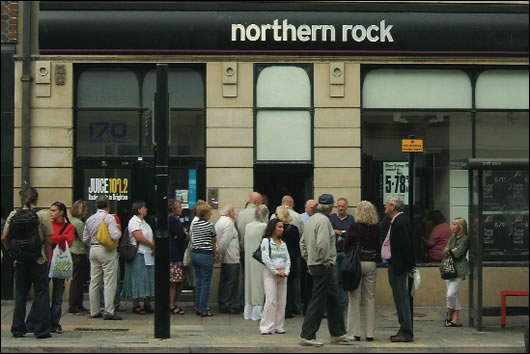
It is possible that if Irish banks get into financial difficulties and are unable to attract investors, then we could see a similar situation to Northern Rock occurring, with the prospect of runs on Irish banks very real
But there are many perils in today's banking world and some losses happen literally overnight and cannot be concealed. For example, a foreign bank with whom an Irish bank was doing business might suddenly collapse, leaving the Irish bank with huge losses. AIB, for example, does a lot of trading in dollars with American banks. It would survive if one of them crashed but if several did simultaneously, it would be in real trouble. Or the auditors might change their rules. The Bradford and Bingley bank in Britain recently had to write off £226 million when KPMG changed its treatment of complex derivatives. Or bonds which the banks had thought were insured might plunge in value because the insurer went bust. Two big bond insurers in the US are known to be in trouble.
Ironically, the hedge funds, which until a few months ago everyone regarded as being supremely risky, have recently been checking with some of the world's biggest banks that it's still safe to deposit cash and securities with them.
If a bank’s losses cannot be ignored, the best thing would be for it to find an investor to put in capital so that its lending did not have to be curtailed. At least $66 billion had to be invested in US and European banks last year after they were hit by the subprime mortgage crisis and the resulting credit crunch. The bigger rescues included a Government of Singapore fund placing $9.7 billion in UBS of Switzerland and the Singapore-based Temasek Holdings buying a 18 % stake in Standard Chartered for $9.2 billion. The Abu Dhabi Investment Authority paid $7.5 billion for a 4.9% holding in Citigroup Inc., and Temasek invested $4.4 billion in Merrill Lynch & Co. with an option to buy an additional $600 million of stock. China Investment Corp. invested $5 billion in Morgan Stanley.
If an Irish bank got into trouble, it would not find it nearly as easy to find an investor as these powerful international institutions, particularly if lots of other banks were failing too. So, if no rescuer emerged, the government would probably have to step in and instruct the Central Bank to provide the missing capital, just as the British government had to do with Northern Rock. It's only alternative would be to allow the bank to appoint a receiver who would freeze the depositors' accounts and gradually release money to them at so many cents for each euro they were owed, year after year until the good loans were repaid or sold, the collateral on the bad ones realised and the winding up was complete.
If one bank went into receivership, depositors would demand their money from the others in cash and, unless funds were made available to them the way they were with Northern Rock, the remaining banks would have to limit withdrawals as happened in Argentina or refuse to pay altogether. Realising this, Jean-Claude Trichet, the head of the European Central Bank has called for all small deposits to be fully insured so that bank runs don't develop.
At present, the only compensation depositors in Irish banks could hope to receive if their bank failed would be from the Central Bank's deposit protection scheme but this is likely to disappoint them. The problem is that the scheme is designed to benefit small depositors and is based on the assumption that only one bank will fail at a time. It covers 90% of the deposits each person holds in a bank up to a maximum total compensation payment of e20,000.
A remarkably helpful woman in the Financial Regulator's office told me that if anyone had e100,000 they wanted to protect, they should lodge e20,000 in each of five banks. That way, if the banks all went bust, the depositor would get e18,000 compensation for each account, making the total loss on their e100,000 lodgment only e10,000. If all the money was in one bank account, however, they would lose e80,000. She neglected to mention that the safest place to put one's money in Ireland is the boring old Post Office with its low interest rates and a 100% state guarantee. Don't confuse it with the PostBank which can only offer the e20,000 compensation.
The compensation money would come from the Deposit Protection Account at the Central Bank into which each commercial bank has to lodge a sum equivalent to 0.2% of the value of the deposits it holds at all its branches in the European Economic Area. At the end of December, 2006, the most recent date for which a figure has been published, the amount in the fund was just e460,570,000, enough to give the maximum compensation to only 23,000 accounts. It is generally recognised that this is grossly inadequate and the EU finance ministers are reviewing the way this and similar schemes operate in all member-states.

Jean-Claude Trichet, the head of the European Central Bank, has called for all small deposits to be fully insured so that bank runs don’t develop
I can see no possibility that Ireland can defuse its debt crisis while remaining in the eurozone. There are only two basic ways to resolve a situation in which the debt burden has become too heavy for the incomes of those carrying the debt to support. One is to cut the debt, a course which could involve the banks writing down the value of the securities they hold and thus having to write-off large chunks of people's savings. This is the default option, the one that gets exercised if a bank is allowed to fail.
The other way would be to increase the incomes of those carrying the debt while holding the debt level constant. This is something a wage inflation would do but that would make Ireland even more uncompetitive if it continued to use the euro. However, re-launching the Irish pound by giving it into circulation and having it float against the euro would maintain competitiveness during a period in which wages were allowed to double in money terms and asset prices were kept on hold.
Of course, neither the Central Bank nor the Department of Finance will publicly discuss the possibility of taking such a radical course. That will only happen when disaster has struck and they are casting around for solutions. It would be nice to believe, however, that they've held some private discussions and are actively investigating what those solutions might be.
Further reading
Just How Sound is the Irish Banking System? Morgan Kelly, Professor of Economics, UCD
- Articles
- Opinion
- Breaking the Bank
- Richard
- Doughwaite
- Recession
- Bank of Ireland
- Economy
- property bubble
- crash
- Northern Rock
Related items
-
 Bank of Ireland unveils new green loans
Bank of Ireland unveils new green loans -
 Reaching for the first rung
Reaching for the first rung -
 Government ‘Help to hoard' scheme - why we’re not building homes
Government ‘Help to hoard' scheme - why we’re not building homes -
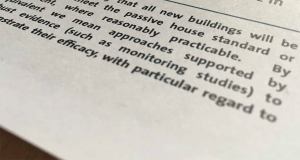 Passive house or equivalent - The meaning behind a ground-breaking policy
Passive house or equivalent - The meaning behind a ground-breaking policy -
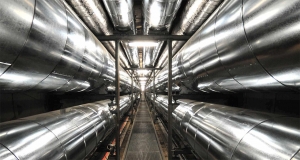 District heating and passive house - are they compatible?
District heating and passive house - are they compatible? -
 How to stimulate deep retrofit
How to stimulate deep retrofit -
 Delivering passive house at scale
Delivering passive house at scale -
 Market demand for sustainable homes massively underestimated - UK survey
Market demand for sustainable homes massively underestimated - UK survey -
 Material impacts
Material impacts -
 Airtightness - the sleeping giant of energy efficiency
Airtightness - the sleeping giant of energy efficiency -
 Passive house goes large
Passive house goes large -
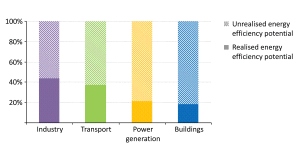 How to rescue retrofit
How to rescue retrofit

